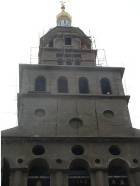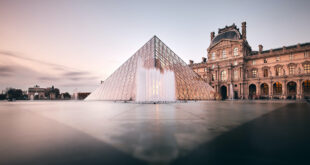 When visiting Uzbekistan, it is easy to be “mosque’d-out”. Even though it is a secular state, there are many mosques and madrassas that can be visited. During our recent visit to the country, we were shown many, as well as several mausoleums and museums. We were there for the annual meeting of the Asian Development Bank and, as with all the Bank annual meetings, attendees were encouraged to take government-sponsored tours. We joined several such tours and, in addition, joined a group of New Zealanders, Australians and Sri Lankans to visit Bukhara and the famous Samarkand. Leith was fortunate in being invited on a special tour by the wife of the Vice-President for VIP spouses and saw a number of sights not accessible to most people, including the ordinary Uzbek.
When visiting Uzbekistan, it is easy to be “mosque’d-out”. Even though it is a secular state, there are many mosques and madrassas that can be visited. During our recent visit to the country, we were shown many, as well as several mausoleums and museums. We were there for the annual meeting of the Asian Development Bank and, as with all the Bank annual meetings, attendees were encouraged to take government-sponsored tours. We joined several such tours and, in addition, joined a group of New Zealanders, Australians and Sri Lankans to visit Bukhara and the famous Samarkand. Leith was fortunate in being invited on a special tour by the wife of the Vice-President for VIP spouses and saw a number of sights not accessible to most people, including the ordinary Uzbek.
The meeting was held in Tashkent, the capital of Uzbekistan. It is a city built on a flat plain and the buildings are comparatively new due to the reconstruction that was needed after the major earthquake of 1966. As a result, there are many fine buildings and large green areas. Built over a shallow water table, the city abounds with fountains and park water features. It is well-served by an underground railways system, tramcars and buses. As all our buses had police escorts, we had little trouble commuting and moving about. To us, Tashkent seemed to be a clean city, and when we said this to locals they fell about laughing. Apparently, when the President says the city is to be clean, residents take his instructions seriously. Perhaps the presence of a large number of policemen on intersections and underground stations gave strength to his instructions!
Uzbekistan, as a former Russian state, uses Russian as its main language, although a significant number of people speak Uzbek. Youth, particularly those in the several universities and polytecs speak English. A knowledge of Russian is an advantage to visitors.
Historic Uzbekistan abounds with evidence of its Islamic history. Many references are made to Tamerlane, a post Genghis Khan ruler who was as much famous for the bloody conquering of a large part of Asia and Europe as he was for making this part of Central Asia famous for its architecture, science and the arts. As one of our books described Tamerlane, “he took a Samarkand of sun-dried brick and left it the architectural pearl of Central Asia.” Much of what we saw owes its origins to Tamerlane and his several descendants.
Bolshevik Russia also lefts its mark and was probably no less bloody than Tamerlane. One of the museums we visited was the Museum of Repression and the exhibits were photos of the arrested intelligentsia, so-called dissidents and anyone that irked the Russian leaders. Several hundred thousand disappeared into the gulags, many never to be heard of again. One book I read while in Uzbekistan described the Bolsheviks’ indifference to people by commenting of 100’s of people being shot almost as a whim of some local official.
But it would be the architecture that we will best remember Uzbekistan for. There are the many mosques, madrassahs and mausoleums that have been rebuilt over the last many years. Indeed, I had thought that they had all survived in their present state through the hundreds of years and it was only when we were guided that the issue of restoration arose. For example, the Ark in Bukhara is now a substantial and large structure that looked 100s of years old but adjacent to it are large piles of dried mud and clay that the originals structure had “melted” to. The government of Uzbekistan and the many international heritage organisations are to be commended for their funding and work. In this short narrative it is not possible to describe all the magnificent places we visited but the Registan in Samarkand stands out for its beauty, magnificence and representation of the various structures.
 But our sightseeing wasn’t limited to Islam! One of our hosted tours in Tashkent included the Russian Orthodox Cathedral and the comparatively new Roman Catholic Cathedral. The former was interesting for the new bell tower that was being constructed (without a hint of the new fire alarm pre-conditions required by our church in Kohimama!) and the wonderful a cappella singing by a small group. The Roman Catholic Cathedral had not long been finished and was impressive for its modern alter and furnishings.
But our sightseeing wasn’t limited to Islam! One of our hosted tours in Tashkent included the Russian Orthodox Cathedral and the comparatively new Roman Catholic Cathedral. The former was interesting for the new bell tower that was being constructed (without a hint of the new fire alarm pre-conditions required by our church in Kohimama!) and the wonderful a cappella singing by a small group. The Roman Catholic Cathedral had not long been finished and was impressive for its modern alter and furnishings.
Our trip was not limited to visits to religious buildings. We had a number of official meals, one in a large Japanese garden, and another alongside a picturesque canal. And the official opening was in a huge convention centre (with a very rare public appearance by the President) that would make John Banks green with envy! One of the more pleasant meals was in a private home, where neither of our hosts knew any English. However, the presence of excellent vodka helped create a spark in the evening! Vodka was a feature at every official function, along with local sweet wine and lashings of local (excellent!!) beer.
 Our trip south to Bukhara was on an overnight train. We had comfortable two-berth cabins and woke to the sight of near-desert country – dusty, salt-panned stretches, broken by low scrub and the occasional Western-style bed out in the open for use by the goat and cattle herders. It looked very unfertile. Occasional pockets of Russian-encouraged industry appeared occasionally and one wondered what living and social conditions might be like.
Our trip south to Bukhara was on an overnight train. We had comfortable two-berth cabins and woke to the sight of near-desert country – dusty, salt-panned stretches, broken by low scrub and the occasional Western-style bed out in the open for use by the goat and cattle herders. It looked very unfertile. Occasional pockets of Russian-encouraged industry appeared occasionally and one wondered what living and social conditions might be like.
The trip back Tashkent from Bukhara and Samarkand was in a cramped mini-bus and the novelty of the stark southern countryside soon lost much of its interest as we tried to get comfortable over the several hours.
On the brighter side, we learned to insist on not constantly eating the unexciting daily Uzbek cuisine and attended a few good restaurants in Samarkand. Our first meal, at a street-side cafe, was very enjoyable, though Leith thought that my miming items from the menu was more likely to result in a musical instrument instead of food! But the daily cuisine – official dinner’s aside – tended to be soup, lamb and bread.
I couldn’t but help compare Tashkent with Kabul in neighbouring Afghanistan. The contrast was immense. Only a few hundred miles separated the two capitals. The former was a modern, green and flourishing city with many modern facilities; Kabul is a war-torn, dusty city consisting run-down, sometimes partly-destroyed buildings with aged buses, cars and modern armoured Humvees. Both have their attractions!
1. These are religious, Islamic places of education.
2. We also saw examples of heritage protection in Lalibela, Ethiopia in 1999
Courtesy of Footplate










Join the Discussion
Type out your comment here:
You must be logged in to post a comment.